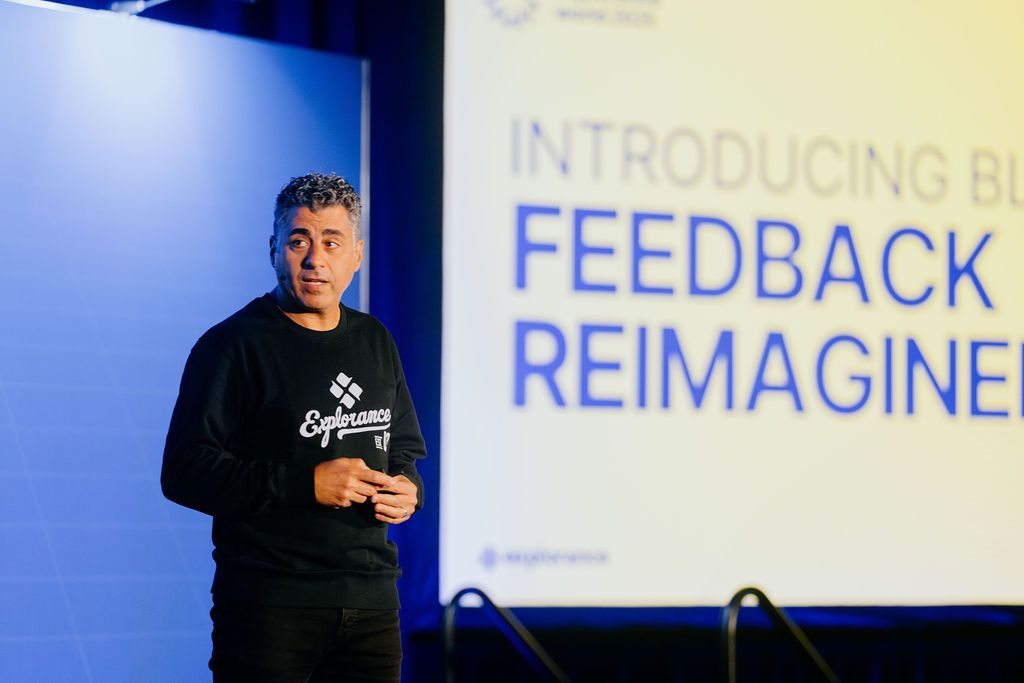Explorance World 2025: Key Takeaways That Signal the Future of Feedback

Picture this: Over 300 thought leaders and technical experts from across various disciplines in higher education and business, all gathered in Montreal and united by one mission—harnessing feedback as a superpower to drive meaningful change.
That was the scene at this year’s edition of Explorance World, which took place from June 8 to 11. Attendees from around the world communed in one of North America’s fastest-growing tech hubs to share best practices, strategies, and thought-provoking insights.
Everyone partook in discussion on important topics related to feedback analytics, turning listening insights into action, and how AI helps accelerate the positive change you can make with it. The fact that the event took place right before the Canadian Grand Prix was set to kick off in Montreal didn’t hurt the atmosphere, either.
This blog post shares some of the essential highlights from a multi-conference that was full of them. For more content from Explorance World 2025, click over to our YouTube channel and watch full keynote recordings and other clips.
Why Feedback is Your Organization's Secret Superpower
Samer Saab, Founder and CEO of Explorance, explored this concept in his keynote, Feedback as a Superpower. He explored the concept of fragility loops: a lack of feedback which leads to decreased performance, negative experiences, anxiety, and ultimately disengagement.
Feedback must be seen as part of the company culture. “If we have a really toxic manager, but we wait until the yearly feedback exercise, just imagine how many employees will have come and gone by then.”
A powerful example shared by Samer was Microsoft. “When Satya Nadella became CEO, he shifted the culture from ‘know-it-all’ to ‘learn-it-all.’ He launched Townhalls to hear directly from employees, introduced a Daily Pulse feedback tool, and made listening a core leadership trait. This cultural shift helped unlock innovation, including the rise of Azure and Microsoft’s advances in AI. This is the true potential of feedback.”
The key insight from Samer's approach is fundamentally changing how organizations think about feedback timing and purpose. Rather than treating feedback as a post-mortem exercise, forward-thinking companies embed listening mechanisms into their daily operations. As he puts it:
"It's really important to shift away from a mindset of looking back and wondering why something happened and instead embed in our ways of listening the capability to actually hear the expression of people in order to minimize anxiety and break out of fragility loops.”
Five Game-Changing Lessons from the Formula 1 Pitlane
Ever wonder what a Formula 1 pit crew and your workplace have in common? More than you'd think, according to coach, mentor, and F1 veteran Marc Priestley.
During his Lessons from the Pitlane keynote, he spoke about how pit crews he’s been involved with studied the tapes and provided a host of suggestions to boost speed and efficiency all while reducing errors. "The most important people giving feedback are the ones closest to the problem.”
Here’s where most companies go wrong when managing a shortcoming: Mistakes lead to finger pointing “When a pit stop goes wrong, the last thing you should do is blame and eject the person at the center. They’re your best source for making sure it never happens again.”
This isn't just a feel-good management philosophy; it's strategic thinking. “If you cut out the person who made the mistake, you lose the insight that might prevent the next one.” The person who experienced the failure firsthand will have the best understanding of it, and the most valuable feedback.
The magic happens when you realize that more than 20 people make up the F1 pit crew, responsible for stabilizing the car, changing the tires, making adjustments to the aerodynamics, and safely releasing the car – all in under 3 seconds. Here are the key lessons:
- Everyone Knows Their Role: All team members know their role, what is within their control, and what others depend on them for. No one is standing around wondering what's going on or how they can contribute.
- Continuous Improvement: Poor preparation is a lousy excuse for a last-minute selfish frenzy – the best teams are always refining their processes.
- Visual Management: Clear signals and communication ensure everyone knows exactly when to act.
These principles aren't just for racetracks. Similar strategies have been implemented in supermarkets and factories with remarkable results.
The AI Revolution You Might Not Even Notice
Here's a plot twist that Rob Nelson, educator and writer, mentioned in his keynote Why You Might Not Even Notice the AI Revolution in Higher Ed or Your Workplace: The most transformative AI applications won't be the flashy ones making headlines.
They'll be the quiet revolutionaries working behind the scenes, fundamentally changing how organizations are managed.
The evolution of AI shouldn’t come as a surprise to us. As Nelson points out, “The filing cabinet changed the way we work—and it has no known inventor.” The most long-lasting innovations are often born from incremental changes to existing technologies. “Thomas Edison may have lit up the history books, but it took a village to electrify a nation,” he added later.
We marvel at AI's human-like qualities and wonder when it'll achieve superhuman intelligence. But that's like admiring a smartphone's camera while missing its ability to connect you to the entire world.
The real impact of any technology doesn’t come from its splashy arrival, but from its eventual integration into people’s daily lives. “The real heroes aren’t just inventors. They’re the people who solved the tiny, boring problems that scaled the future.”
This concept is fundamental in a field like education, where AI’s arrival and subsequent integration has been seen with warranted caution “When ChatGPT first hit the headlines, it was all about the duck of doom—a cheating machine signaling the end of writing and education as we know it.
“But there’s also the rabbit of glad tidings. AI can take on the boring parts—lesson plans, grading, even emails—and give educators back their time.” The fact that AI carries both hope and perils can be seen in almost every new technological advancement in modern times.
Of course, it can be difficult to choose the right viewpoint to adopt. “The same tool that threatens to displace us can also personalize learning and re-engage students. The question is: what do you choose to see?”
Consider how large AI models excel at using word vectors to present relationships among combinations of words. When you constrain results to a limited, structured database with links, confabulations aren't a problem. This addresses real issues, such as how keyword searches of titles and course descriptions often fail to connect similar ideas across disciplines effectively.
The revolution isn't about replacing human decision-making. It's about augmenting it with unprecedented insight and coordination capabilities. As Rob notes, this may sound boring, "but it is also a real thing that actually existing AI technology can do."
Explorance Unveils BlueX 2.0: Moving Beyond Pure Forms
Here's the kind of innovation that gets us genuinely excited. On June 10, 2025 (right during Explorance World), Samer Saab and the Explorance team officially launched BlueX 2.0, and it's not just an update – it's a complete reimagining of what feedback can be.
"BlueX 2.0 is built for everyone who listens – and for everyone who has something to say," explains Samer. "It's a leap forward that transforms how feedback is invited, shared, and expressed. This is how we build clarity, culture, and connection – at scale."
What makes BlueX 2.0 revolutionary:
- From asking to expression: More than a survey tool, BlueX 2.0 is a platform for expression that helps organizations shift from simply asking questions to creating experiences that invite conversation, creativity, and reflection
- Battle-tested innovation: Reimagined drawing on input from 49 organizations, analysts, and changemakers across sectors to create a platform that enables interactive content, creative prompts, self-reflection spaces, and storytelling experiences
- Anyone can use—powerfully: Combines an intuitive drag-and-drop builder with advanced logic, multimedia embedding, and real-time analytics, plus advanced reporting with interactive visualizations and flexible sharing workflows
- Unlimited use, zero barriers: Licensed at the organizational level, BlueX 2.0 offers unlimited users, surveys, and creative formats—across all departments and roles. No hidden fees. No limits.
- Smart integration, instant impact: Integrates effortlessly with Explorance Blue, sharing authentication, data pipelines, and reporting infrastructure while also functioning as a powerful standalone solution
This isn't just a product launch; it's the practical application of everything Samer talked about in his keynote BlueX: Built for Everyone Who Listens. BlueX 2.0 embodies his vision of breaking those fragility loops by making feedback continuous, accessible, and genuinely engaging.
When organizations can move beyond the annual survey ritual to create ongoing conversations that actually invite participation, that's when feedback truly becomes a superpower.
The Future is Brighter Than You Think
We're actually living through one of the most exciting times in human history for education and employee listening.
Organizations that will thrive in the next decade aren't the ones avoiding changes, rather, they're the ones harnessing the technological shifts we're experiencing right now for positive, lasting impacts on teaching and learning – whether in academic or business contexts.
Think about it: we have unprecedented access to data, tools that can analyze human sentiment at scale, and AI that can help us understand patterns we never saw before. The combination of human insight and technological capability is creating possibilities previously inconceivable.
The future isn’t something to fear - it’s something to shape, and with the right mindset and tools, we’re more equipped than ever to shape it for the better.
Ready to Shift into High Gear with Your Feedback?
Formula 1 pit stops are decided in the hundredths of a second, and millions of dollars are spent on ensuring every moment of that time is optimized. The organizations that thrive will be those that master the art of rapid, intelligent adaptation.
Explorance World 2025 isn't just about learning new techniques – it's about joining a community of innovators who see feedback not as a necessary evil, but as the fuel for organizational transformation.
The pit lane is ready. The crew is assembled. Are you ready to take your organization to the next level?
